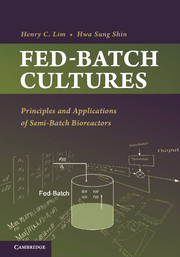Book contents
- Frontmatter
- Contents
- Preface
- Acknowledgments
- 1 Introduction to Fed-Batch Cultures
- 2 Idealized Reactors and Fed-Batch Reactors
- 3 Maximization of Reaction Rates and Fed-Batch Operation
- 4 Phenomena That Favor Fed-Batch Operations
- 5 Classification and Characteristics of Fed-Batch Cultures
- 6 Models Based on Mass Balance Equations
- 7 Non–Equation-Based Models
- 8 Specific Rate Determination
- 9 Optimization by Pontryagin's Maximum Principle
- 10 Computational Techniques
- 11 Optimization of Single and Multiple Reactions
- 12 Optimization for Cell Mass Production
- 13 Optimization for Metabolite Production
- 14 Simple Adaptive Optimization
- 15 Measurements, Estimation, and Control
- 16 Feasibility Assessment and Implementable Feed Rates
- Index
- References
1 - Introduction to Fed-Batch Cultures
Published online by Cambridge University Press: 05 April 2013
- Frontmatter
- Contents
- Preface
- Acknowledgments
- 1 Introduction to Fed-Batch Cultures
- 2 Idealized Reactors and Fed-Batch Reactors
- 3 Maximization of Reaction Rates and Fed-Batch Operation
- 4 Phenomena That Favor Fed-Batch Operations
- 5 Classification and Characteristics of Fed-Batch Cultures
- 6 Models Based on Mass Balance Equations
- 7 Non–Equation-Based Models
- 8 Specific Rate Determination
- 9 Optimization by Pontryagin's Maximum Principle
- 10 Computational Techniques
- 11 Optimization of Single and Multiple Reactions
- 12 Optimization for Cell Mass Production
- 13 Optimization for Metabolite Production
- 14 Simple Adaptive Optimization
- 15 Measurements, Estimation, and Control
- 16 Feasibility Assessment and Implementable Feed Rates
- Index
- References
Summary
A living cell of a microbial, plant, or animal source is essentially an expanding and dividing biochemical reactor in which a large number of enzyme-catalyzed biochemical reactions take place. Microbial cultures involve live microbial cells, while tissue cultures involve live plant or animal cells. These cultures can be run, as in the case of chemical and biochemical reactions, in three classical operational modes: batch, continuous, or semi-batch (semi-continuous). For the past three decades, there has been tremendous growth in the use of semi-batch reactors in the fermentation, biotechnology, chemical, and waste-treatment industries owing to increasing demands for specialty chemicals and products and to certain advantages semi-batch reactors provide. Batch and semi-batch processes are used to handle usually low-volume, high-value products such as fermentation products, including amino acids and antibiotics, recombinant DNA products, and specialty chemicals. Owing to high values of these products, profitability can be improved greatly even with marginal improvements in yield and productivity. Therefore, there are incentives to optimize batch or semi-batch reactor operations.
For a batch or semi-batch process, the objective is to maximize the profit that can be realized at the end of the run, at which time the reactor content is harvested for further processing such as separation and purification. Thus, the problem is called end point optimization as only the end, not the intermediate, results are relevant to the overall profit.
- Type
- Chapter
- Information
- Fed-Batch CulturesPrinciples and Applications of Semi-Batch Bioreactors, pp. 1 - 18Publisher: Cambridge University PressPrint publication year: 2013
References
- 1
- Cited by



